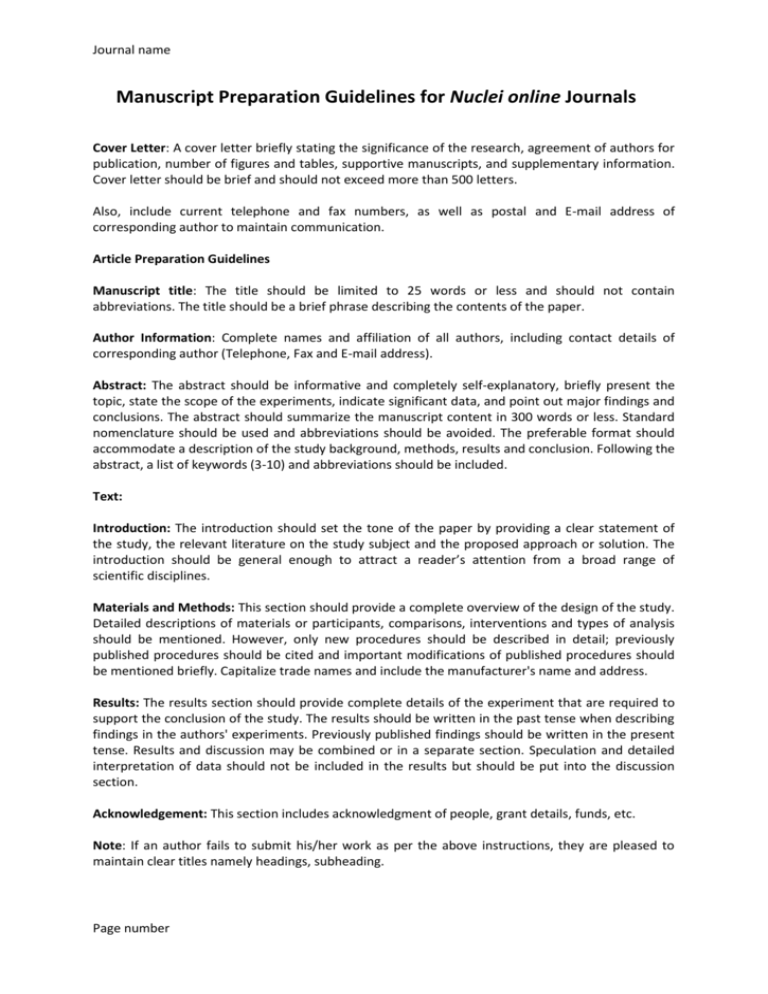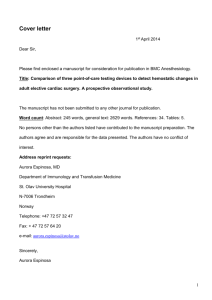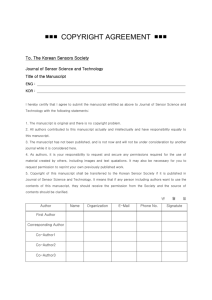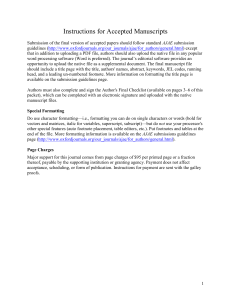Manuscript Preparation Guidelines for Nuclei online Journals
advertisement

Journal name Manuscript Preparation Guidelines for Nuclei online Journals Cover Letter: A cover letter briefly stating the significance of the research, agreement of authors for publication, number of figures and tables, supportive manuscripts, and supplementary information. Cover letter should be brief and should not exceed more than 500 letters. Also, include current telephone and fax numbers, as well as postal and E-mail address of corresponding author to maintain communication. Article Preparation Guidelines Manuscript title: The title should be limited to 25 words or less and should not contain abbreviations. The title should be a brief phrase describing the contents of the paper. Author Information: Complete names and affiliation of all authors, including contact details of corresponding author (Telephone, Fax and E-mail address). Abstract: The abstract should be informative and completely self-explanatory, briefly present the topic, state the scope of the experiments, indicate significant data, and point out major findings and conclusions. The abstract should summarize the manuscript content in 300 words or less. Standard nomenclature should be used and abbreviations should be avoided. The preferable format should accommodate a description of the study background, methods, results and conclusion. Following the abstract, a list of keywords (3-10) and abbreviations should be included. Text: Introduction: The introduction should set the tone of the paper by providing a clear statement of the study, the relevant literature on the study subject and the proposed approach or solution. The introduction should be general enough to attract a reader’s attention from a broad range of scientific disciplines. Materials and Methods: This section should provide a complete overview of the design of the study. Detailed descriptions of materials or participants, comparisons, interventions and types of analysis should be mentioned. However, only new procedures should be described in detail; previously published procedures should be cited and important modifications of published procedures should be mentioned briefly. Capitalize trade names and include the manufacturer's name and address. Results: The results section should provide complete details of the experiment that are required to support the conclusion of the study. The results should be written in the past tense when describing findings in the authors' experiments. Previously published findings should be written in the present tense. Results and discussion may be combined or in a separate section. Speculation and detailed interpretation of data should not be included in the results but should be put into the discussion section. Acknowledgement: This section includes acknowledgment of people, grant details, funds, etc. Note: If an author fails to submit his/her work as per the above instructions, they are pleased to maintain clear titles namely headings, subheading. Page number Journal name References: Only published or accepted manuscripts should be included in the reference list. Meetings abstracts, conference talks, or papers that have been submitted but not yet accepted should not be cited. All personal communications should be supported by a letter from the relevant authors. Nuclei Online uses the numbered citation (citation-sequence) method. References are listed and numbered in the order that they appear in the text. In the text, citations should be indicated by the reference number in brackets. Multiple citations within a single set of brackets should be separated by commas. When there are three or more sequential citations, they should be given as a range. Example: "... now enable biologists to simultaneously monitor the expression of thousands of genes in a single experiment [1,5-7,28]". Make sure the parts of the manuscript are in the correct order for the relevant journal before ordering the citations. Figure captions and tables should be at the end of the manuscript. Authors are requested to provide at least one online link for each reference as following (preferably PubMed). Because all references will be linked electronically as much as possible to the papers they cite, proper formatting of the references is crucial. Please use the following style for the reference list: Examples: Published Papers: 1. Siegel R, Naishadham D, Jemal A (2012) Cancer statistics, 2012. CA Cancer J Clin 62: 10-29. doi:10.3322/caac.20138. PubMed: 22237781. 2. Pui CH, Mullighan CG, Evans WE, Relling MV (2012) Pediatric acute lymphoblastic leukemia: where are we going and how do we get there? Blood 120: 1165-1174. doi:10.1182/blood-2012-05378943. PubMed: 22730540. 3. Hardie DG (2011) AMP-activated protein kinase: a cellular energy sensor with a key role in metabolic disorders and in cancer. Biochem Soc Trans 39: 1-13. doi:10.1042/BST0390001. PubMed: 21265739. Note: Please list the first five authors and then add "et al." if there are additional authors. Electronic Journal Articles Entrez Programming Utilities 1. http://eutils.ncbi.nlm.nih.gov/entrez/query/static/eutils_help.html Books: 1. Baggot JD (1999) Principles of drug disposition in domestic animals: The basis of Veterinary Clinical Pharmacology. (1stedn), W.B. Saunders Company, Philadelphia, London, Toranto. 2. Zhang Z (2006) Bioinformatics tools for differential analysis of proteomic expression profiling data from clinical samples. Taylor & Francis CRC Press. Conferences: 1. Hofmann T (1999) The Cluster-Abstraction Model: unsupervised learning of topic hierarchies from text data. Proceedings of the International Joint Conference on Artificial Intelligence. Page number Journal name Tables: These should be used at a minimum and designed as simple as possible. We strongly encourage authors to submit tables as .doc format. Tables are to be typed double-spaced throughout, including headings and footnotes. Each table should be on a separate page, numbered consecutively in Arabic numerals and supplied with a heading and a legend. Tables should be self-explanatory without reference to the text. Preferably, the details of the methods used in the experiments should be described in the legend instead of in the text. The same data should not be presented in both table and graph form or repeated in the text. Cells can be copied from an Excel spreadsheet and pasted into a word document, but Excel files should not be embedded as objects. Note: If the submission is in PDF format, the author is requested to retain the same in .doc format in order to aid in completion of process successfully. Figures: The preferred file formats for photographic images are .doc, TIFF and JPEG. If you have created images with separate components on different layers, please send us the Photoshop files. All images must be at or above intended display size, with the following image resolutions: Line Art 800 dpi, Combination (Line Art + Halftone) 600 dpi, Halftone 300 dpi. See the Image quality specifications chart for details. Image files also must be cropped as close to the actual image as possible. Use Arabic numerals to designate figures and upper case letters for their parts (Figure 1). Begin each legend with a title and include sufficient description so that the figure is understandable without reading the text of the manuscript. Information given in legends should not be repeated in the text. Figure legends: These should be typed in numerical order on a separate sheet Tables and Equations as Graphics: If equations cannot be encoded in MathML, submit them in TIFF or EPS format as discrete files (i.e., a file containing only the data for one equation). Only when tables cannot be encoded as XML/SGML can they be submitted as graphics. If this method is used, it is critical that the font size in all equations and tables is consistent and legible throughout all submissions. • • • Suggested Equation Extraction Method Table Specifications Equation Specifications Supplementary Information: Discrete items of the Supplementary Information (for example, figures, tables) referred to at an appropriate point in the main text of the paper. Summary diagram/figure included as part of the Supplementary Information (optional). All Supplementary Information is supplied as a single PDF file, where possible. File size within the permitted limits for Supplementary Information. Images should be a maximum size of 640 x 480 pixels (9 x 6.8 inches at 72 pixels per inch). Page number Journal name Proofs and Reprints: Electronic proofs will be sent as an e-mail attachment to the corresponding author as a PDF file. Page proofs are considered to be the final version of the manuscript. With the exception of typographical or minor clerical errors, no changes will be made in the manuscript at the proof stage. Authors will have free electronic access to the full text (HTML, PDF and XML) of the article. Authors can freely download the PDF file from which they can print unlimited copies of their articles. Copyright: Submission of a manuscript implies that the work described has not been published before (except in the form of an abstract or as part of a published lecture, or thesis) and that it is not under consideration for publication elsewhere. All works published by OMICS Group are under the terms of the Creative Commons Attribution License. This permits anyone to copy, distribute, transmit and adapt the work provided the original work and source is appropriately cited. Page number







